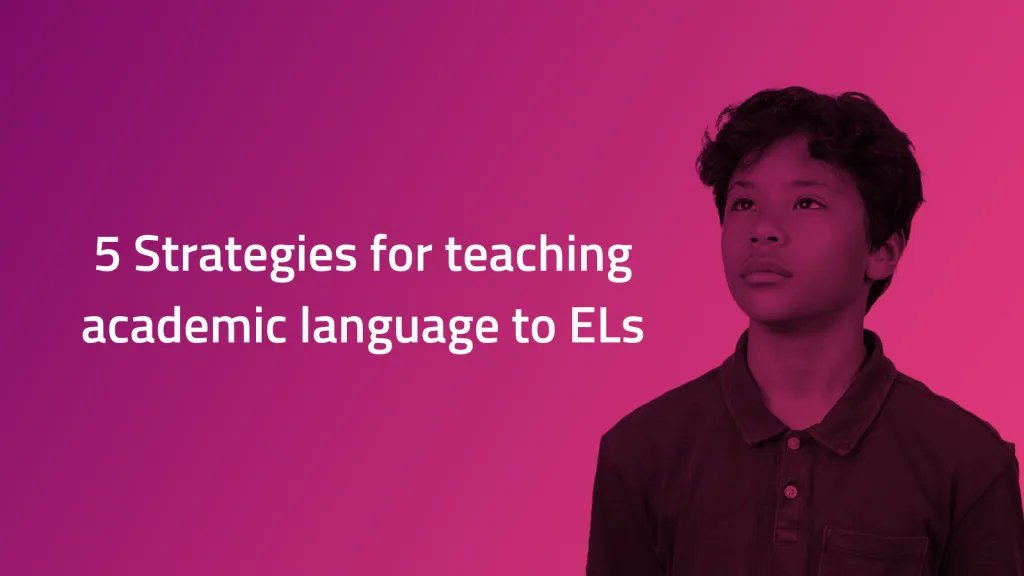5 Strategies for Teaching Academic Language to ELs


5 Strategies for Teaching Academic Language to ELs
Academic language is not just a challenge for English learners (ELs) in our classrooms - it is something that all students may struggle with.
Indeed, math instruction is filled with vocabulary that many students won’t be exposed to outside of the lesson. Especially ELs. Think about the academic language in this seemingly simple concept:
“The product of the first two consecutive even integers is divisible by two.”
At least 5 words in the sentence are potential pitfalls for anyone who has not been exposed to the appropriate academic language.
Teachers must be intentional about supporting all students accordingly and have the tools and strategies to do so. For months, we’ve been interviewing experts in academic language to compile the best tools and strategies for effective math instruction.
Set your students up for success with these five proven strategies for teaching academic language:
- Use routines to facilitate mathematical thinking and discourse
- Front-load academic language before whole group instruction
- Use what worked during remote learning
- Track student progress to ensure data-driven instruction
- Build relationships and make connections

1. Use routines to facilitate mathematical thinking and discourse
Grace Kelemanik and Amy Lucenta, authors of the book Routines for Reasoning: Fostering the Mathematical Practices in All Students, share how building in daily classroom routines, such as turn-and-talks, have countless benefits for ELs.
Routines can support conversations about academic thinking, and provide opportunities for students to build confidence. They can also encourage students to go beyond sharing an answer to talking through how they arrived at that answer. This will be critical when we return to classrooms in the fall and teachers are trying to pinpoint where each students’ learning has been interrupted during the pandemic.
2. Front-load academic language before whole group instruction
Finding ways to expose ELs to key lesson vocabulary before they try to learn the math is not only crucial for students’ ability to grasp the concept, but is also a huge time-saver for teachers. Math content expert Pam Burgreen spoke in-depth about this topic and about how her team created Math vocabulary primers - short video lessons that are standards aligned. This allows teachers to spend less time creating additional resources for ELs so they can use instructional time more effectively.
3. Use what worked during remote learning
Many students and teachers are understandably feeling the technology burnout after a year of remote learning. But that doesn’t mean we should forget about the tools we relied on during remote learning.
Kristian Lindsey, a middle school math teacher and interventionist in Austin ISD, TX, plans to do recreate the Zoom chat feature during in person instruction. She and others have found this a simple, low-risk way for ELs to participate and share responses privately with their teacher. We’ve seen many teachers use tools like Padlet and PollEverywhere effectively, but there are many options to choose from.
Other technology like well-crafted videos, individual progress-monitoring tools and engaging virtual activities may all have a place when combined with traditional in-person learning instruction.
4. Track student progress to ensure data-driven instruction
Distance learning has reinforced the need to design personalized learning pathways for students who learn in different ways and at different rates.
Math Content Manager Pam Burgreen discusses how Ellevation Math allows teachers to gauge student progress. Students answer a confidence question before the lesson, as well as a few vocabulary related and math related questions throughout. This data gives teachers a much clearer picture of where that student is and how their time together would be best spent.
5. Build relationships and make connections
You’ve heard it before - students learn better when they have strong relationships with their teachers. This is particularly true for those who may already be struggling socio-emotionally and academically.
Austin ISD’s 2018 Teacher of the Year Steven Mendoza uses simple mantras like, “Be respectful and do your best” to create strong learning communities built on trust - both remote and in person.
Steven also recognized that students - particularly ELs - better understand math when they can conceptualize the lesson. Bringing students’ experiences into lessons can be as simple as using common home items/materials in problems or offering an open-ended word problem and allowing students to fill in the scenario.
To get access to strategies and resources from experts in multilingial education, join the almost 10,000 educators in our ELL Community - its free!